|
Bennett's life
in the Potteries
Baby, boy and young man
NOTE: quotations are from
Warrillow's - 'Arnold Bennett and Stoke-on-Trent'
|
Enoch Arnold
Bennett was born in Hope Street Hanley in 1867, his teenage years were spent in
Cobridge, a suburb of Burslem, that lies about the road leading south to Hanley.
Known as Trafalgar road in Bennett's novels, it is in fact the Waterloo road of
today. |
After their marriage in 1866, Enoch and Sarah Bennett took up residence in
a wedge-, or coffin-shaped house-shop having frontages or side to Hope
Street and Hanover Street, Shelton. Shelton was a large
sub-district of Hanley in the 19th Century the boundaries of which ran far
in various directions.
on May 27th 1867 the Bennett Family Bible records that, "at half-past
ten o'clock a.m. at 90, Hope Street, Hanley, the baby Arnold was born."
It was at this house during the early months of babyhood that the child
Enoch Arnold lived with the young parents who were busily engaged in the
small drapery, pawnbroking and sewing business. In addition the father,
Enoch, was studying law. "At No. 90 the ground floor was filled with
books." It was at the age of 34, in 1876, that Enoch passed his final
examinations in law.
Hope Street, Hanley
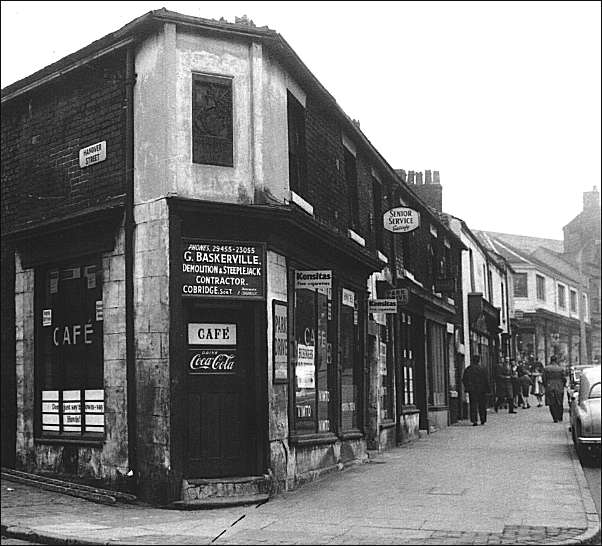
Arnold Bennett's birth home
on the corner of Hanover Street and Hope Street
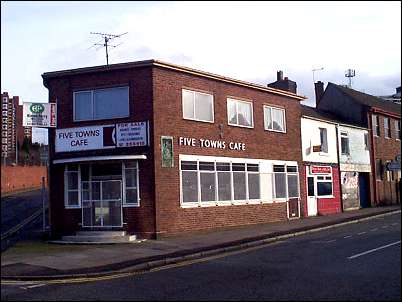
later
"Five Towns Cafe" on the
location where Arnold Bennett,
the novelist was born in 1867
[the cafe is now demolished]
Hanover Street to the
left and Hope Street to the right.
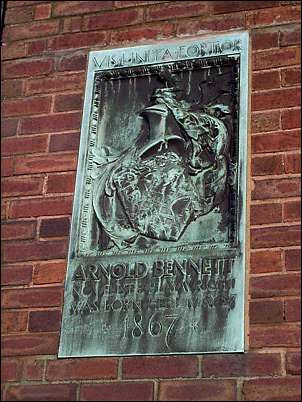
this plaque is visible on both the cafe
buildings above
photos: Dec 2000
the
move back to Burslem
The Bennett family
had left their Hope Street home in 1875 and moved to a house with a
lower rental in Dale Hall, Burslem, where the family lived for about a
year.
It was a period when the family found themselves at their lowest ebb. In
1876 conditions improved for the family, when the Longsons of St. John's
Square, Burslem, offered at a modest rent the use of a house, 175,
Newport Lane, Burslem. It seemed that in return Mrs. Bennett returned to
the shop in St. John's Square, once again to assist behind the counter.
By this time Arnold Bennett the boy had reached the age of about 8 or
9 and from 1875-6 received his education in company with his brother
Frank at the infant school of the Wesleyan Chapel and Sunday School at
Swan Square, Burslem. He moved to the Burslem Endowed School at the
Wedgwood Institute in 1877.
Arnold was a thoughtful type of boy hampered by a stutter in his
speech that remained with him, in a greater or lesser degree, throughout
his lifetime. It prompted his father to say, "What shall I do with poor
Arnold; he will never be able to earn his own living ?"
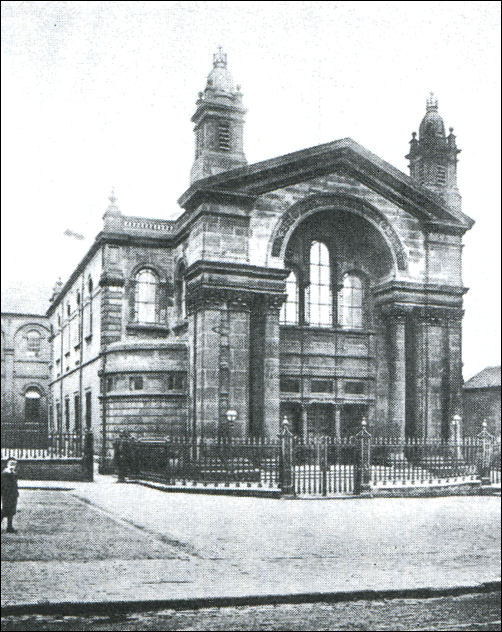
Swan Bank Wesleyan
Methodist Chapel, Burslem - c.1908
photo: the Warrillow Collection
from 1875-6 Arnold
Bennett received his education at the infant school of the Wesleyan
Chapel and Sunday School at Swan Square,
"The Wesleyan Chapel on Duck Bank, Swan Bank, Burslem,
photographed about the time 'The Old Wives' Tale' was written. This was
the chapel at which the Baines family worshipped."
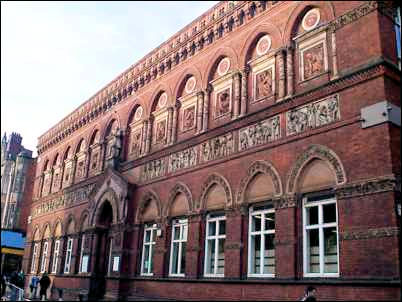
the Wedgwood Institute,
Queen Street, Burslem
In 1877
Arnold continued his education
at the Burslem Endowed School at the Wedgwood Institute.
Cobridge
In Bennett's books Cobridge was known as Bleakridge
- the area dates back to the thirteenth century, when the monks of
Hulton Abbey first occupied the land.
“A house stood on a hill. And that hill was
Bleakridge, the summit of the little billow of land between Bursley and
Hanbridge. Trafalgar Road passed over the crest of the billow."
Arnold
Bennett was very familiar with Cobridge and the little station there
-because he lived there from 1880 to 1888 ....
Bennett's father
Enoch, had bought a building site on Henry
Meakin’s estate for £200 in 1879 where he built a house at a cost of
£900, No 205 Waterloo Road. This is a large three-storey red brick house
with a façade much embellished with terra cotta. It has two bay windows
at the front and six bedrooms.
There is no information about the architect but there is a good
possibility that it was designed by George Ford, who was living on the
other side of Waterloo Road, he designed other streets and houses on the
Meakin estate and was likely
the model for Osmond
Orgreave, the architect in Bennett's novel 'Clayhanger'
In Clayhanger the Orgreave family, of which the head
(Osmond, the architect) is essential to the development of Edwin’s
maturity.
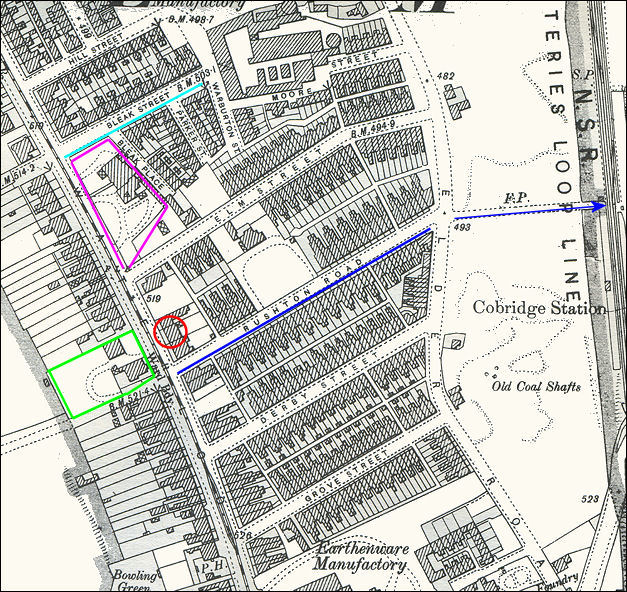
1898 map showing where Arnold Bennett lived
The red
circle on Waterloo Road was Bennett's home from 1880 to 1888, the blue
line was originally to be named Station Road - because the footpath at
the end lead to Cobridge Station. It became Rushton Road acknowledging
the ancient 'Rushton Grange' estate.
The green
square opposite Bennett's house was the home of
George Ford the architect who designed many local houses - he was likely
the model for Osmond Orgreave, the architect in Bennett's novel 'Clayhanger'.
The Cobridge Territorial Army Centre now occupies this ground.
Marked in light
blue is Bleak Street and in purple the location of Bleak Hill House -
these are the names Bennett took when he named Cobridge as Bleakridge.
In the mid 1950's Bleak Street was renamed Orgreave Street after the
architect in Bennett's Clayhanger.
Bleak Hill House
has since been demolished and a Mosque now occupies this ground.
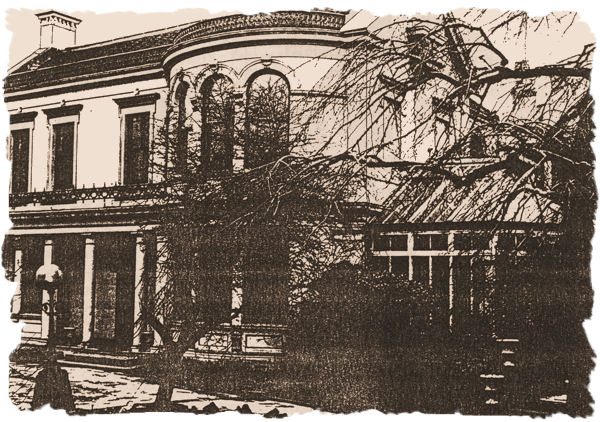
Bleak Hill House in 1955
Warrillow Collection - Keele University Library
|
“A house stood on a hill. And that hill
was Bleakridge, the summit of the little billow of land
between Bursley and Hanbridge. Trafalgar Road passed over
the crest of the billow.
Bleakridge was certainly not more than a hundred feet higher
than Bursley; yet people were now talking a lot about the
advantages of living ‘up’ at Bleakridge, ‘above’ the smoke,
and ‘out’ of the town, though it was not more than five
minutes from the Duck Bank. To hear them talking, one might
have fancied that Bleakridge was away in the mountains
somewhere. The new steam-cars would pull you up there in
three minutes or so, every quarter of an hour. It was really
the new steam-cars that were to be the making of Bleakridge
as a residential suburb. It had also been predicted that
even Hanbridge men would come to live at Bleakridge now.
Land was
changing owners at Bleakridge, and rising in price. Complete
streets of lobbied cottages grew at angles from the main
road with the rapidity of that plant which pushes out
strangling branches more quickly than a man can run. And
these lobbied cottages were at once occupied.
Cottage-property in the centre of the town depreciated. The
land fronting the main road was destined not for cottages,
but for residences, semi-detached or detached. Osmond
Orgreave had a good deal of this land under his control.
He did
not own it, he hawked it. Like all provincial, and most
London, architects, he was a land-broker in addition to
being an architect.
Before obtaining a commission to build a house, he
frequently had to create the commission himself by selling a
convenient plot, and then persuading the purchaser that if
he wished to retain the respect of the community he must put
on the plot a house worth of the plot.”
Arnold Bennett - Clayhanger |
|
As the road continues southward towards
Hanley, you pass small eighteenth century buildings, which, the further
you venture from the Mother Town, give way to the larger and obviously
more affluent middle class terraces of the mid 1900's. Number 205
Waterloo Road was one of the many Bennett family homes.
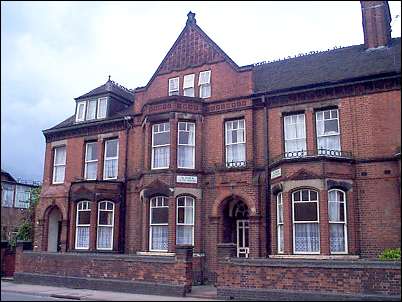
205 Waterloo Road
former home of Arnold Bennett
photo: 2001
In 1960 the house was given over to an
Arnold Bennett Museum. However it is now a private home. The Bennett family also lived at 198 Waterloo road, while in
Burslem itself, they resided first in Dane Street and then in Newport
Lane.
Edwin
Clayhanger at Bursley cemetery
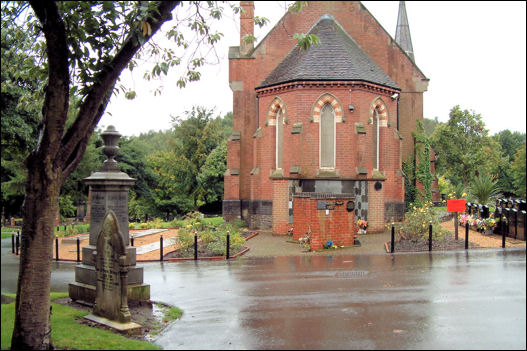
Arnold Bennett's monument
to the left of the chapel
Arnold Bennett, in his book
'These Twain', has Edwin Clayhanger attending a funeral at the Wesleyan
Chapel in Duck Square (actually Swan Square), Burslem and then an
interment at Burslem Cemetery - the following is a selection of that
event.......
|
"Edwin was met by a
saying that 'the last journey must be the longest':
which meant that the cortege must go up St Luke's Square
and along the Market Place past the Town Hall and the
Shambles, encountering the largest number of sightseers,
instead of taking the nearest way along Wedgwood Street.
Edwin chose Wedgwood Street.
Edwin scrutinized the coffin, and the wreaths,
and the cards inscribed with mournful ecstatic affection
that nestled amid the flowers, and the faces of the
audience, and his thought was: 'This will soon be over
now!
The cortege moved. Rain was threatening, and the
streets were muddy.
At the cemetery it was raining, and the walkers
made a string of glistening umbrellas; only the paid mutes
had no umbrellas....
Vehicles, by some municipal caprice, were forbidden
to enter the cemetery. And in the rain, between the
stone-perpetuated great names of the town's history -the
Boultons, the Lawtons, the Blackshaws, the Beardmores,
the Dunns, the Longsons, the Hulmes, the Suttons, the
Greenes, the Gardiners, the Calverts, the Dawsons, the
Brindleys, the Bainses, and the Woods - the long
procession proceeded by Auntie Hamps tramped for over a
third of a mile along the asphalted path winding past
the chapel to the graveside. And all the way Mr Breeze,
between Edwin and Albert, with Bert a yard to the rear,
talked about boils, and Edwin said Yes and No, and
Albert said nothing. And at the graveside the three
ministers removed their flat round hats and put on
skull-caps, while skilfully holding their umbrellas
aloft.
And while Mr Flowerdew was reading from a little
book in the midst of the large, encircling bare-headed
crowd with umbrellas, and the gravedigger with absolute
precision accompanied his words with three castings of
earth into the hollow of the grave, Edwin scanned an
adjoining tombstone, which marked the family vault of
Isaac Plant, a renowned citizen. ....
.......And even in that hilly and bleak
burial-ground, with melancholy sepulchral parties and
white wind-blown surplices dotted about the sodden
slopes, and the stiff antipathetic multitude around the
pit which held Auntie Hamps, and the terrible seared,
harsh, grey-brown industrial landscape of the great
smoking amphitheatre below, Edwin felt happy in the
sensation of being alive and of having to contend with
circumstance."
Arnold Bennett, These Twain (1916) |
|
|
.... some 15 years later Bennett's ashes were to be
interred in the same cemetery.
The
internment of Arnold Bennett's ashes
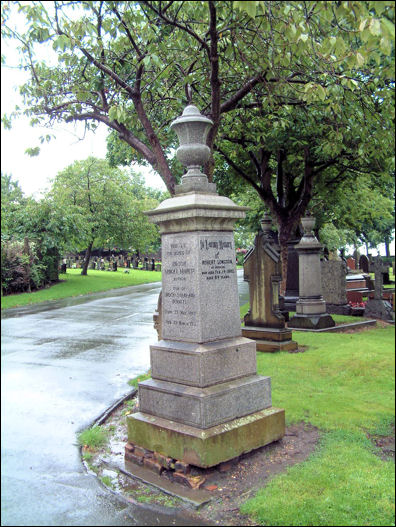
MR ARNOLD BENNETT'S ASHES
Internment at Burslem Cemetery
"In accordance with the
unanimous decision of the near relatives, and in pursuance of the believed
desire of the writer himself; the ashes of Mr Arnold Bennett, were
interred at Burslem Cemetery today, the service being of the simplest and
most private character.
The only mourners present as the beautiful and hallowed words of the
committal prayers were recited were the widow (Mrs Arnold Bennett), Mrs
Beardmore (the eldest sister) and Mr Frank Bennett (brother).
Though the ceremony was thus
so characteristic of the austere and the retiring nature of North
Staffordshire's greatest interpreter, there was not lacking the
companionship of the sights and sounds which he knew and described so
well.
The brilliant freshness of
the cemetery green, beneath the sunny sky, contrasted with the
overlooking grey pitmound, which shut out the view of "Bursley." Away to
the left the hill could be seen climbed by "Trafalgar road." A slight
breeze sighed through the trees, and in the distance an engine working
on the colliery sidings could be heard, its continuous "chuff -chuff"
being softened almost to a croon.
The internment was in the
grave where Arnold Bennett's mother and grand-parents lie - on the east
side of the chapel, near the centre of the cemetery. Above the grave there
is a grey granite monument.......
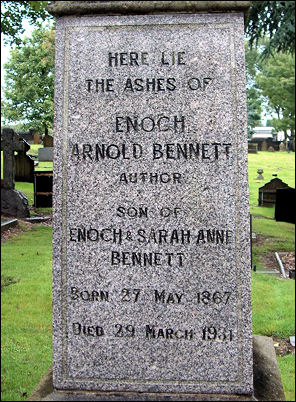
Exceptional precautions had
been taken to secure the privacy of the service, and even the officiating
clergyman - the Rev A L Lamb, Rector of Burslem - was not informed until
he entered the cemetery office today the identity of the ashes over whom
he was to read the service.
The ashes were conveyed from
Colder 's Green Crematorium today by train, accompanied by Mr T Bridgman
(of Messrs J Kenyon Ltd, London, the under-takers). In the same train Mrs
Bennett and Mrs Beardmore travelled to Stoke. Mr Frank Bennett travelled
to Stoke from Rochdale today, and there met the ashes, and the party
proceeded by car to the cemetery. The two ladies waited at the graveside,
while Mr Bennett and Mr Kenyon went
to the cemetery lodge, there meeting Mr Myatt, superintendent Registrar of
the City Cemeteries, and Mr A Walker, Assistant Registrar at Burslem
Cemetery.
Led by the Rector of
Burslem, the party - consisting of Mr Bennett, Mr Myatt and Mr Bridgman -
then made their way slowly to the grave. Mr Bennett himself carried the
ashes, which were contained in a bronze casket of severe, but graceful
design, on which was inscribed, in plain Roman lettering: "Enoch Arnold
Bennett, died 27th March, 1931, aged 63 years."
Thus, though the suggestions
that the internment should take place in the Potters' Corner in Stoke
Parish Church, or elsewhere in circumstances permitting public homage to
North Staffordshire's distinguished son, have been overruled the district
has received back its own. Enoch Arnold Bennett travelled widely and
achieved greatly in many fields, but it is fitting that the soil which he
trod in youth, and trod again so often in imagination, should afford his
ashes their last resting place."
Evening Sentinel, 22
July 1931
 |
![]() | Bennett Index |
| Bennett Index |![]()
![]()
![]() also see: locations
and people in Bennett's novels
also see: locations
and people in Bennett's novels![]()
![]()
![]() also see: locations
and people in Bennett's novels
also see: locations
and people in Bennett's novels